If you’re seeking to explore the works of Gian Lorenzo Bernini in Rome, look no further than my comprehensive guide to the Bernini Trail. As one of the most significant artists of 17th century Rome, Bernini worked under nine popes and left an indelible mark on the city’s cultural heritage.
This guide provides an overview of Bernini’s fascinating life and directs you to the locations of his magnificent artworks and sculptures throughout Rome.
From the beautiful churches to the picturesque piazzas, the best museums to the secret palaces, Bernini’s masterpieces can be found in some of the most breathtaking locations in the city.
Gian Lorenzo Bernini was the greatest sculptor of the Baroque. The Baroque period was characterized by exuberance, excess, movement, intensity, and formal glamor.
The term Baroque means “misshapen pearl” in Italian. That’s the art of Bernini in a nutshell — sensual and evocative.
Not your typical idealized and distant sculpture stuck on a pedestal. Bernini’s works are dramatic and full of movement and immediacy, sometimes like shock theater in the round.
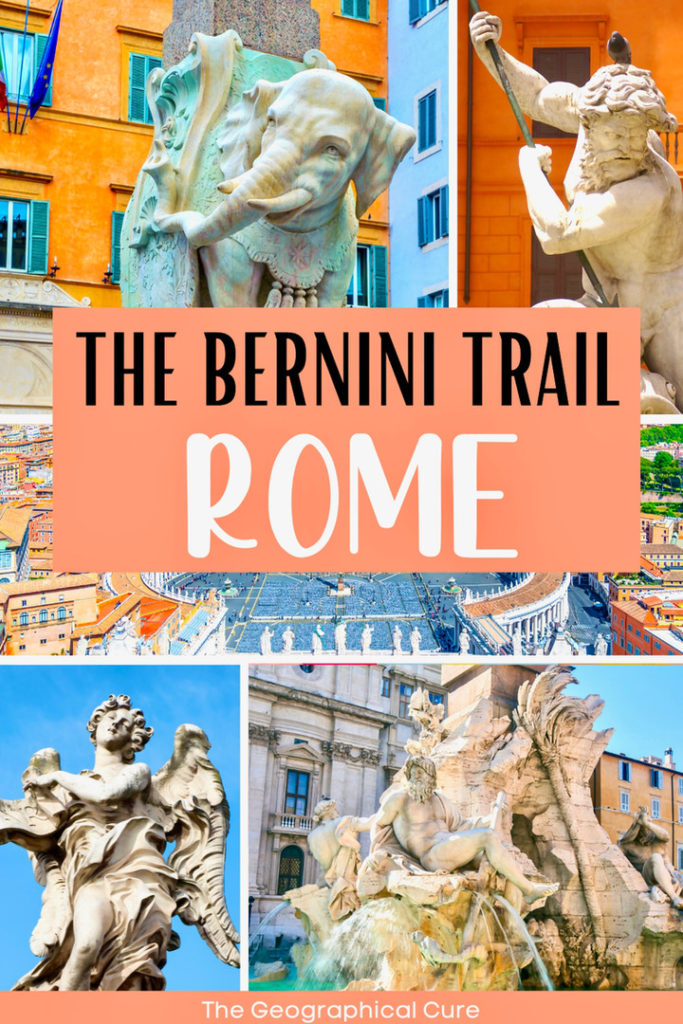
Dubbed the “animator of marble,” Bernini left his artistic stamp everywhere in Rome. He helped define the city you see today. His works are some of Rome’s top attractions.
Bernini was a prodigy and genius. Like Michelangelo before him, Bernini had an all encompassing virtuosity. And he was prolific for many decades, a fevered workaholic who rarely turned down a commission.
Bernini didn’t confine himself to sculpting, though he’s most renowned for that medium. Bernini was also a painter, architect, playwright, and stage manager.
He excelled in every form of sculpture — portraits busts, mythological sculptures, religious groupings, public fountains, and funeral tombs.
In this guide, I take you on a tour of Bernini’s masterpieces in Rome. Some of them are in Rome’s toniest museums.
Others can be seen for free in public squares and churches. If you like to travel with a theme, a Bernini pilgrimage is one of the most unique things to do in Rome.
Who Was Gian Lorenzo Bernini?
Before discovering where to see Bernini’s art in Rome, let’s find out more about the life of this revered artist.
1. Early Life
Bernini was born in Naples in 1598. His father Pietro was a sculptor. Bernini was in his studio at just age 5 and showed early promise.
Legend holds that Bernini created his first significant sculpture, The Goat Amalthea, at just age 8. That attribution may have been Bernini exaggerating the facts to burnish his legacy. Art historians think the table sculpture is from his early teens.
Still, a group sculpture in the round at an early age is a preposterously sophisticated work. When Cardinal Maffeo Barberini (later Pope Urban VIII) saw it, he branded Bernini the “next Michelangelo.” This tidbit may also derive from Bernini himself. Invented or not, the “prediction” came true.
Bernini arrived in Rome at age 7 and almost never left. When he was older, to appear more cultured, Bernini told people he was from Florence, not rough and tumble Naples. He became a Rome chauvinist, scorning France and other artistic centers.
For the most part, Bernini was a charmer. Unlike Michelangelo, he was the perfect courtier to a succession of popes. He was cut out for the ambitious pursuit of fame.
Bernini was charismatic, popular, witty, handsome, and a devout Catholic. He had a hot temper, but largely channeled the “heat of the heart” into his art.
Bernini had friends in high places. Commissions flowed in. His early patron was Cardinal Scipione Borghese, the nephew of Pope Paul V.
The sculptures Borghese commissioned established Bernini’s reputation as a master carver in his 20s. Bernini went on to work for a succession of 8 popes.
2. Bernini, a Ladies’ Man Driven Mad
For decades, Bernini had a reputation as a ladies’ man. He was single until he was 41.
But during his bachelor days, around 1636, Bernini met Costanza Bonarelli. She was the beautiful and educated wife of one of his assistants, Matteo Bonarelli. She would literally drive Bernini mad — the one instance where an otherwise careful Bernini was diverted off the fast track to success.
Bernini became obsessed with Costanza and the two began an affair. It’s unclear how they met. She may have modeled for him.
It’s also unclear if the relationship was purely voluntary on Costanza’s part, though it was reported as passionate. Seeing Bernini’s interest, Matteo may have pimped out his wife or sanctioned the affair to win Bernini’s favor.
One of Bernini’s most beautiful portrait sculptures is a marble bust of Costanza. She appears singularly youthful and passionate.
She’s depicted slightly disheveled, lips parted, and blouse agape. As if the pair had just finished an amorous encounter.
The bust is now in the Bargello Museum in Florence, which specializes in sculpture. It’s considered the perfect example of a Bernini “speaking likeness” — a bust where Bernini’s subject is caught in an act, rather than merely posing.
At the time, only aristocrats were enshrined in marble. Nor did artists usually create expensive and informal marble busts just for themselves. It was likely a sign of Bernini’s deep love
But the love affair had a tragic denouement. Bernini heard a whiff of gossip that Costanza might have another lover, possibly his brother Luigi. He was insanely jealous.
Bernini falsely told Luigi and Costanza that he was leaving town. Instead, late at night, he stood outside Luigi’s house to spy on them. To his horror, he saw Costanza kiss his brother Luigi goodbye.
In a homicidal rage, Bernini chased Luigi through Rome, beating him with an iron bar. He broke Luigi’s ribs and had him exiled to Bologna.
Bernini sent a manservant to slash Costanza’s face with a razor blade. She was also briefly imprisoned in an institute for wayward women.
What was Bernini’s punishment for this savage event? Not much. Pope Urban VIII, a Bernini fanboy, told Bernini he was sentenced to marry and settle down.
Bernini received a beautiful Italian heiress of his choosing, Caterina Tezio. He apparently never strayed again.
The couple were married for 34 years and had 11 children. However, none of his children inherited an ounce of Bernini’s prodigious talent.
Even after he married, Bernini kept Costanza’s bust for 3 years in his studio. He finally gifted it to the Medici family in Florence (perhaps at his wife’s urging). But Bernini still kept a double portrait he had created for the rest of his life.
On his death, someone in his family cut the double portrait in two. The half with Costanza is lost. Scholars don’t know which of Bernini’s self portraits may have been part of the double portrait.
There’s one reminder of the torrid affair that you can still see today. In St. Peter’s Square, Bernini carved a heart in the purple marble in the center of the square.
The heart is sliced in two, indicative of a broken heart. It’s near the marble plate of the wind to the left of the obelisk as you face the basilica.
3. Bernini’s Rivalry with Borromini
Bernini had a sharp rivalry with fellow architect Giovanni Borromini. They often vied for the same jobs. Their conflict was legendary. Most of the time, Bernini prevailed and was the darling of the popes.
Personality wise, Bernini and Borromini were opposites. Unlike the charming Bernini, Borromini was an intense and embattled loner. He was rancorous and quick tempered. He eventually committed suicide with a sword at age 67.
READ: Guide To Palazzo Spada and the Borromini Perspective Gallery
The pair of sworn enemies bickered like children. They worked together, not happily, on the Palazzo Barberini and St. Peter’s Basilica. Bernini thought big. But Borromini worked with a jeweler’s precision.
One legendary example of their animus is the feud of the Piazza di Spagna. Borromini worked on a palace (a commission he stole from Bernini) opposite Bernini’s house.
Borromoni sculptured donkey ears pointing at Borromini. In response, Bernini sculpted a penis pointing at Borromini’s building. Both sculptures were later removed.
4. Bernini’s Later Career
In his later career, Bernini had less time for his “speaking likeness” busts and portraits (which he didn’t let his workshop artists touch). He was busy with many papal commissions.
He focused principally on architecture, especially the grandiose projects for St. Peter’s Basilica discussed below.
Bernini died at 81 in 1680, a very lengthy life at the time. He was buried in the Basilica of Santa Maria Maggiore.
At his death, Bernini was widely considered Europe’s greatest artist. Along with Caravaggio, Bernini left a deep mark on one of the longest periods of art history. He was the last of a series of Italian artist geniuses, marking the end of Italy’s hegemony in the art world.
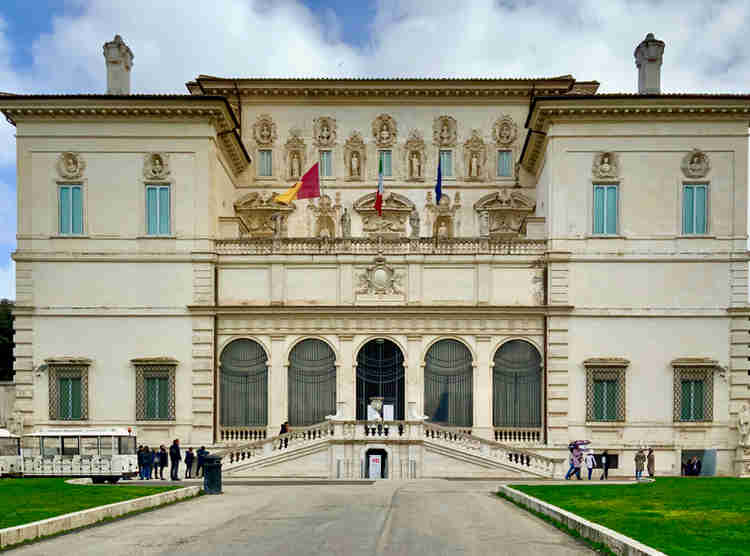
Guided Tours In Rome
There are no guided tours that exclusively feature Bernini. But you can book a small group tour of the Borghese Gallery, which houses his most famous works. Or you can opt for a private tour of the museum.
If you don’t take a guided tour of the Borghese, you will only be able to visit if you pre-book a time slot ticket.
You can also book tours that include Bernini and other artists. On this 2 hour guided tour, you can walk in the footsteps of Bernini, Borromini, and Michelangelo.
Or, you can book a private walking tour of the works of Bernini and Caravaggio.
Where To Find Bernini’s Art in Rome
Let’s follow in Bernini’s footsteps in Rome and discover his most famous pieces. Here’s where to find Bernini’s most famous art works in Rome and Vatican City.
1. Borghese Gallery
The Borghese Gallery is hands down the best place in Rome to see the most exquisite work of Bernini. It houses some of Bernini’s most spectacular sculpture — David, Apollo and Daphne, and The Rape of Persephone. He completed them in his 20s. They’re more pagan than his later religious sculptures.
Bernini’s David appears like an olympic athlete in swirling motion. His feet are wide apart and he twists to gain the maximum swing for his shot at Goliath. The intensity of his gaze and energy are palpable. You can feel his resolution.
David’s face is that of Bernini’s. A mirror was held up for Bernini as he chiseled it.
Bernini’s David is often compared and contrasted with Michelangelo’s Renaissance statue of David. While Michelangelo’s sculpture is calm and serene, Bernini’s David is full of emotion and in attack mode.
The graceful Apollo and Daphne is my very favorite of Bernini’s sculptures. It was inspired by a passage in Ovid’s Metamorphoses where a mischievous Cupid holds sway.
Apollo is struck by Cupid’s golden arrow. Overwhelmed by lust, he chases after Daphne. But Daphne’s simultaneously been struck by a lead arrow of disgust. She cries out to her father, a river god, for help. He transforms her into a laurel tree.
Bernini captures the moment of transformation, with the pair’s arms and legs moving in space and Daphne partially transformed into a tree. The details are so good that the sculpture seems real rather than merely mythological. Bernini turns hard cold marble into yielding flesh, fluttering leaves, and tangled tresses.
Newly renovated and cleaned, the sculpture is pristine. And it’s subject matter remains relevant — a ravenous man who won’t take no for an answer.
The Rape of Persephone was created when Bernini was only 24. The twisting contropposto sculpture is a tour de force of action and emotion.
Bernini takes the classic story of the abduction of Persephone from Roman mythology as his theme. Pluto, king of the underworld, falls passionately in love with Persephone (also known as Proserpina).
He violentally abducts her. Bernini captures the climatic moment in visceral life-like detail.
In the heart rending sculpture, Pluto seizes a crying Persephone. Terrified, she fights to free herself from her molester.
You can see indentations in Persephone’s leg from Pluto’s firm grip. Cerberus, the three-headed guard dog, sits at Pluto’s leg barking with fangs bared.
In addition to these three epic sculptures, the Borghese Gallery is a full house of Bernini masterpieces. You can also these Bernini pieces:
- Portrait of a Boy (1638)
- Self Portrait (2 versions, 1623, 1630-35)
- Portrait of Urban VIII (1632)
- Bust of Cardinal Borghese (2 versions, 1632)
- Bust of Pope Paul V (1618-20)
- The Goat Amalthea (1609-15)
- Truth Revealed by Time (1646-52)
- Aeneas, Anchises, and Ascanius Fleeing Troy (1618-19)
Click here to book a skip the line ticket for the Borghese Gallery.
2. Capitoline Museums
The Capitoline Museums are packed with masterpieces spanning the ancient to Renaissance periods. The museums are especially rich in sculpture, especially Greco-Roman sculpture. Naturally, the museums holds some Bernini works.
The most Bernini famous piece there is his Medusa, a bust of the serpent-headed Gorgon with a petrifying glare from Greek myth.
It’s set under a Murano glass chandelier in the Hall of Geese. In the sculpture, Bernini captures the anguish of Medusa as she realizes her fate.
According to the poet Ovid, Medusa was renowned for her loveliness. But when Poseidon raped her in the Temple of Athena, Athena was ticked off. She transformed Medusa’s glorious mane of hair into snakes — a symbol of female rage.
This way, Medusa’s enemies were numbed with fear and turned to stone. Medusa became both a beautiful victim and a monstrous villain, put to use by Perseus.
In Bernini’s rendition of the myth, Medusa is shown alive and in the very moment of transformation. Medusa peers into an unseen mirror in anguish. (Bernini liked moments of metamorphosis.)
The second Bernini piece in the Capitoline Museums is the monumental Statue of Urban VIII, a frequent Bernini subject.
The statue is in the Hall of the Horatii and Curiatti, a large frescoed room. It sits across the room from a statue by Bernini rival Algardi, the Statue of Innocent X.
Here’s my complete guide To the Capitoline Museums. Click here to book a skip the line ticket.
3. Piazza Navonna
Piazza Navona is dominated by the beautiful Fountain of Four Rivers, Fontana dei Quattro Fiumi. It was designed by Bernini for Pope Innocent X. But Bernini almost didn’t get the commission.
Bernini had many rivals. Some had the ear of the new pope, Pope Innocent X, who succeeded urban VIII. Their influence was strong. When Innocent X commissioned designs for the fountain from leading architects of Rome, he excluded Bernini.
One of Bernini’s allies, Nicole Ludovisi, persuaded Bernini to prepare a model anyway. Ludovisi then displayed it in the Palazzo Doria Pamphilj, which the pope passed through every day.
As anticipated, when the pope saw the model, he was in ecstasy. He observed: “He who desires not to use Bernini’s designs, must take care not to see them.”
So Bernini won the contest for the fountain. In it, you see four muscular statues representing the river gods. There’s a lot going on.
The gods represent the four great rivers of the world: the Danube, the Ganges, the Rio del Plato, and the Nile. They gather around an Egyptian obelisk.
The fountain is festooned with palm trees and animals. A dove representing the Doria Pamphilj family sits atop the obelisk.
The fountain faces the Borromini-designed Sant’Agnese Church. Bernini lost the commission for the church to Borromini. Legend holds that Bernini expressed his disdain for Borromini’s project through his fountain.
Nile hides his face from the sight of the church. The Rio del Plata god has his hands raised, as if to protect himself if Borromini’s church falls down.
It makes for a good story, but it’s just apocryphal. The fountain was completed before the church.
READ: Complete Guide To Piazza Navona
4. Spanish Steps
At the foot of the Spanish Steps in Piazza di Spoagna, you’ll find Bernini’s Barcaccia or the Fountain of the Leaky Boat.
Urban VIII commissioned it as part of his initiative to place a fountain in every public square of Rome. Bernini worked on it with his father Pietro.
The unusual fountain was inspired by a boat that washed up on the piazza during one of Rome’s floods. The fountain was intended to supply Romans with pure drinking water.
So it wasn’t purely decorative. It was restored in 2014, so it’s sparkling white.
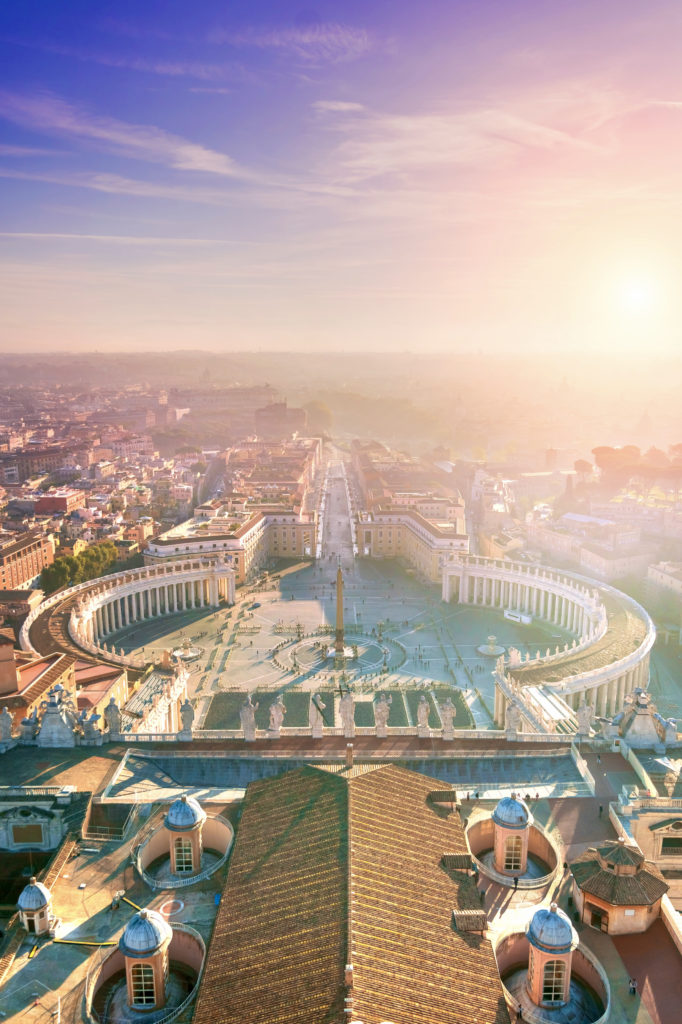
5. St. Peter’s Square
St. Peter’s Square is one of the most famous landmarks in Italy. The square is dominated by the world’s largest church, St. Peter’s Basilica.
In 1656, Pope Alexander VII commissioned Bernini to build a vast square worthy of the basilica. Bernini created an elliptical plaza with two semi circular colonnades, consisting of four rows of Doric columns.
The colonnades represent a pair of stretched and embracing arms, welcoming pilgrims to the basilica. If you stand on the foci (marble plates) near the fountain designed by Carlo Maderno, the columns line up perfectly behind one another.
On the balustrade at the top of the columns are 140 statues of saints, martyrs, and popes crafted by Bernini’s workshop. At the center is is an Egyptian obelisk brought to Rome by Caligula around 37 AD.
The paving stones of the square are cobblestone and travertine marble. They radiate from the central hub of the obelisk. The square is a magnificent entry point to the basilica.
6. St. Peter’s Basilica
St. Peter’s Basilica is one of the world’s most ornate churches. It’s filled with art by the greatest artists of the era. Bernini either carved or designed many of the works in St. Peter’s Basilica, including:
- Baldachin (1623-34)
- Tomb of Urban VIII (1647)
- Monument to Alexander VII (1672-78))
- Constantine on Horseback (1662-68)
- St. Longinus (1629)
- Chair of St. Peter (1640)
- Altar of the Santissimo Sacramento Chapel (1673-74)
- Tomb Monument to Countess Matilda (1633)
The Baldachin is the most famous piece, commissioned by Urban VIII. It’s an elaborate and curvaceous bronze canopy covering the high altar. The bronze is so dark it looks like wood. At the top, there are four large angels in each corner.
The Baldachin sits directly under St. Peter’s dome and directly above St. Peter’s tomb. It was intended to suggest the vastness of god’s creation (and of the Barberini pope). To create the piece, Bernini recruited his father Pietro and brother Luigi to assist.
Urban VIII claimed that bronze for the Baldachin was purloined from the portico of the ancient Pantheon. The populace objected, saying “What the barbarians didn’t do before, the Barberini is doing now.”
In reality, the stolen bronze was used for canon balls and the bronze for the Baldachin imported from Venice.
The Tomb of Urban VIII was commissioned by the pope himself. Carved in white marble, the pope wears the papal tiara (a triple crown), his arm extended in a blessing. The figure of Charity is possibly portrait of Costanza.
The (rather overwrought) Chair of St. Peter is in the apse near the front of the basilica. Bernini’s sculpture glorifies the chair as symbol of power.
The chair hovers and is received (but not supported) by four aristocrats. Above the chair is an oculus of light, with cherubs and the holy spirit in its center.
But perhaps the most impressive of Bernini’s St. Peter’s sculptures is the Chigi tomb. The Tomb of Alexander VII is one of Bernini’s last works. It’s set in a large niche like a freestanding monument.
The pope is at the top praying, surrounded by four virtues — Charity, Truth, Prudence, and Justice. The focal point is a gilded bronze statue of the angel of death.
The angel’s head and face are shrouded in jasper drapery. He holds a “memento mori,” an hourglass, symbolizing death.
Click here to book a skip the tour of the basilica with a dome climb.
7. Vatican Pinacoteca
The Vatican Pinacoteca is the art gallery of the Vatican Museums. It houses plaster casts from 16567 that Bernini used to create the massive bronze sculpture of the Chair of St. Peter in St. Peter’s Basilica.
The busts are of St. John and St. Athanasius. They’re about 4 feet tall.
The angels are 8 feet tall. They look massive in the museum and very small on the basilica sculpture.
8. Doria Pamphilj
The Doria Pamphilj is an exquisite gallery in Rome. It has one of the finest collections of art in private hands, with many representations of Pope Innocent X, a family member.
READ: Secret Palace Museums in Rome
In his early years, Innocent X earned as reputation as an upright, if taciturn, pope. But later, he became erratic, impatient, and morose. He was a famously ugly man. People described him as deformed and vulgar.
Bernini softens this depiction in his bust, idealizing the majesty of the papacy. Bernini portrays a dynamic Innocent X, gazing up. His eyebrows are slightly raised, giving him an air of indifference. The white marble suggests purity.
Here’s my complete guide to the Doria Pamphilj. Click here to book a skip the line ticket.
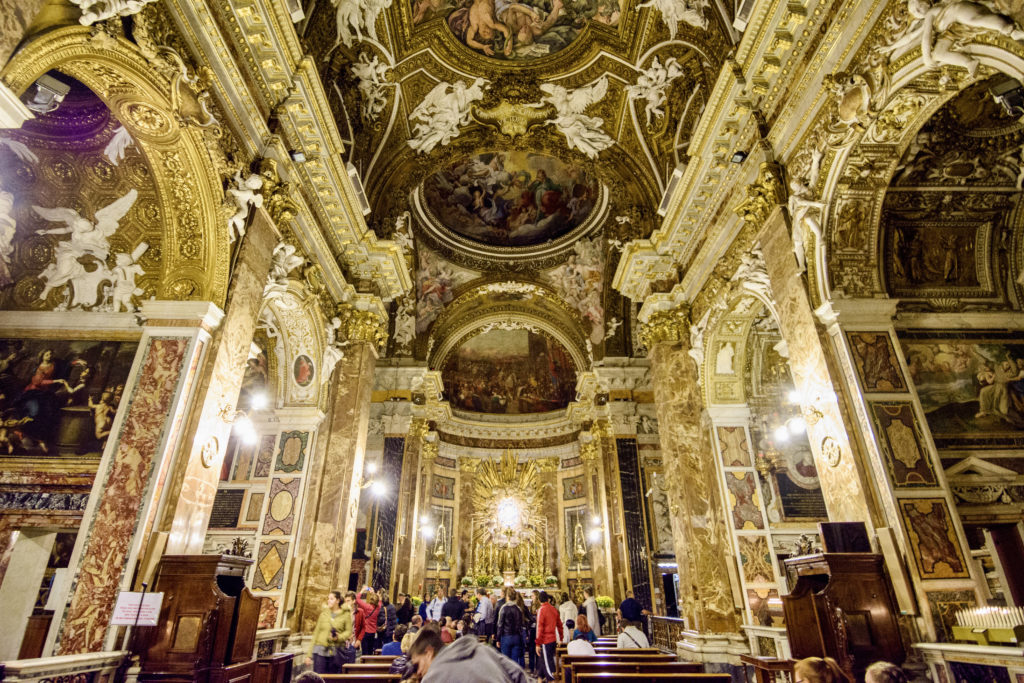
9. Santa Maria Della Vittoria, 1645-52
This church houses one of Bernini’s most dramatic and startling sculptures, the Ecstasy of St. Teresa, in the Cornaro Chapel.
It depicts the moment when an angel pierces Saint Teresa’s heart with the golden arrow of divine love. St. Teresa wasn’t your average saint. She was a Spanish nun who had full body mystical visions.
The risqué sculpture is a complex ensemble, Bernini stagecraft at the height of his maximalism ethos. The sculpture hovers above in an elevated niche.
St. Teresa is on a cloud with golden rays of light pouring down on the moment of intense emotion. On the walls of the chapel, members of the Cornaro family gather in “theater boxes” to witness the divine moment.
But is it divine? A swooning St. Teresa’s mouth is open in rapture. Her head tilts back. Art historians have noted that Teresa even resembles Bernini’s love Costanza.
Scholars disagree about the exact nature of the saint’s “ecstasy.” Some believe the image is frankly erotic, depicting a sexual experience.
Others think it just reflects divine passion. Bernini likely knew exactly what he was doing, creating a potent cocktail of piety and eroticism to tap into human experience.
To my mind, the sculpture is overdone. Others love the piece because it breaks down the barrier between the viewer and the audience. Bernini himself was proud of it, calling it “the least bad thing I have ever done.”
10. Santa Maria Sopra Minerva
Before you enter the church, check out the “Bernini Elephant” in the center of Piazza della Minerva. It’s an eccentric piece.
It consists of an Egyptian obelisk on the back of an elephant. Bernini designed the oddity, and it was sculpted by one of his assistants.
Legend holds that Bernini took liberties with the elephant’s position. He deliberately sculpted the elephant smiling with its tail held to the side.
The elephant appears about to leave a “gift” behind it, pointed at the house of a Bernini rival. Baroque Rome … you have to love it.
Inside the Santa Maria Sopra Minerva, you’ll find a few other Bernini sculptures. The best one is the Memorial to Maria Raggi, a nun who performed miracles.
It’s very unique with wavy flowing drapes of gold marble and bronze. The sculpture is attached to a pillar along the nave, in a then revolutionary sepulchral style.
11. Piazza Barberini & Palazzo Barberini
Two of Bernini’s fountains grace the Piazza Barberini, home to one of Rome’s hidden gems, the Palazzo Barberini Museum. They are the Fountain of the Triton and the Fountain of the Bees.
The Fountain of the Triton, dating from 1642, was Bernini’s last public commission from Urban VIII. It marked the first time a decorative public fountain was ever seen in a European city center.
The Fountain of the Bees is an homage to the Barberini family. It’s a giant seashell with three bees drinking from the water spouts. Bees were the symbol of the Barberini family.
Unfortunately, the fountain was vandalized by greedy would be collectors who cut off the stone bees. The fountain was removed in 1880 and a copy of the original Bernini fountain inaugurated in 1916.
Inside the Palazzo Barberini itself, you’ll find Bernini’s Portrait of Urban VIII. In the bust, Bernini does his usual emotive work.
It’s all in the details — the unshaven hair on the pope’s chin, the deeply incised irises, the detailed eyebrows, and the shape of his eyes. Bernini gives the impression of life, as if the pope were standing before you.
12. Church of San Francesco a Ripa
This secret Trastevere church houses one of Bernini’s greatest late works, the Blessed Ludovica Albertoni. It’s located in the Altieri Chapel, placed in the deep space above an altar. It seems like a companion piece to Bernini’s St. Teresa.
Like St. Teresa, the Blessed Ludovica portrays a nun in the ecstasy of communing with God. For centuries, naughty observers have viewed it as carnal.
The sculpture undoubtedly has palpable erotic energy. Ludovica’s hand is on her breast and head thrown back.
It may seem odd that Bernini was praised for a sexual depiction of a religious moment. But, in the Baroque, the combination of the carnal and spiritual was seen as perfectly normal.
13. Ponte Sant’Angelo
The magnificent Castle Sant’Angelo Bridge is the most beautiful bridge in Rome. It’s the main path from Rome to Vatican City.
Dating to 138 AD, the bridge was built by Emperor Hadrian. In 1688, to put an exclamation point on the bridge, Pope Clement IX commissioned Bernini to decorate it with angels.
Bernini designed 10 fluttering sculptures, popularly known as the “breezy maniacs.” 2 of the 10 Bernini carved himself, The Angel with the Scroll and The Angel with the Crown of Thrones.
The pope deemed Bernini’s originals too precious to be exposed to the elements. So the sculptures lining the bridge today are copies.
14. Basilica of Sant’Andrea delle Fratte
This 17th century basilica is dedicated to Saint Andrew. This is where you can find two of Bernini’s original angels. It’s just off the Via Veneto, not far from Piazza Barberini.
They’re in the sides of the presbytery, which is a part of the church reserved for clergy. You can see the Angel with the Crown of Thorns and the Angel with the Scroll.
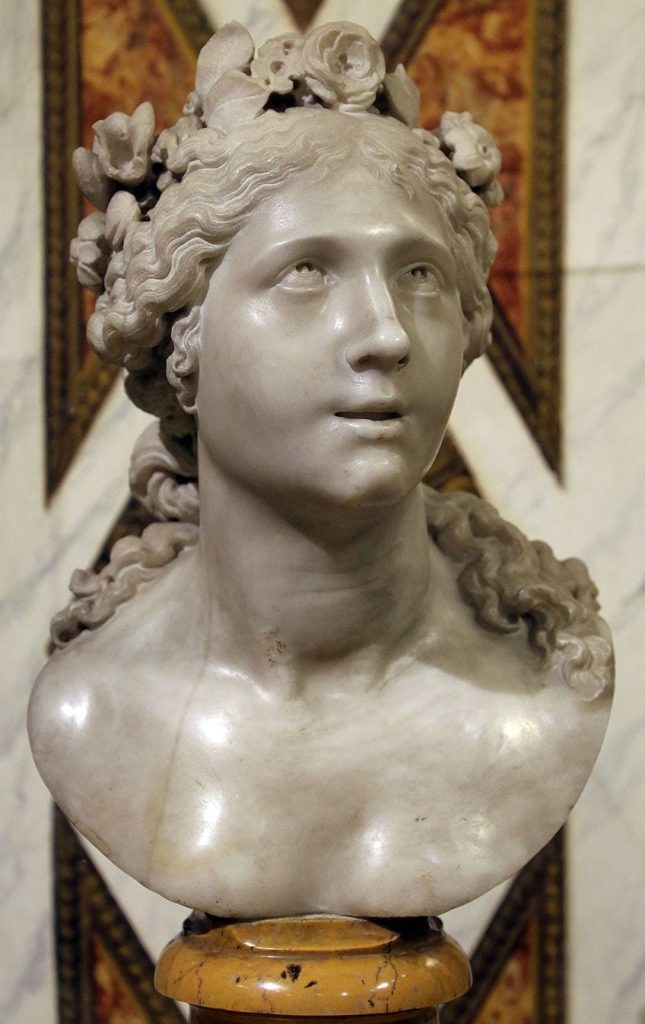
15. Palazzo di Spagna
The Palazzo di Spagna is at the bottom of the Spanish Steps. The palace is home to the Spanish Embassy. The palace boasts two Bernini sculptures, Damned Soul and Blessed Soul.
Bernini created Damned Soul when he was only 20 years old. The bust shows a man screaming in agony, his face contorted. Some believe it to be a self portrait, with Bernini piercing himself in front of a mirror to faithfully reproduce the tormented visage.
It’s a classic example of Bernini producing art reflecting intense emotion. Such a depiction of a face had never been produced before. Busts like this paved the way for artists to experiment with depicting the human body.
In contrast to the Damned Soul, the Blessed Soul is a vision of sweetness and inner beauty. The bust depicts a redeemed soul.
She raises her head and looks towards heaven. Her parted lips and large eyes convey the innocence that Gian Lorenzo wanted to capture.
16. Chigi Chapel in the Church of Santa Maria del Popolo
The Chigi Chapel is in the beautiful church of Santa Maria del Popolo. It’s an impressive, and sadly overlooked, attraction in Rome. The church not only features sculptures by Bernini, but paintings and frescos by Caravaggio and Raphael.
For this chapel, Bernini carved two sculptural groups from 1655-61, Daniel in the Lions’ Den and Habakkuk and the Angel.
These two sculptures show the beginning of Bernini’s late style, with slightly more elongated figures characteristic of the earlier Mannerism. Daniel is the superior one.
In it, a young Daniel reaches his arms toward heaven, praying to escape the lion. The flowing drapery is pure Bernini.
17. Basilica San Sebastiano fuori le mura
This church is the home of Bernini’s very last work, Salvator Mundi, finished in 1679. It’s a marble bust of Christ, the “savior of the world.” Bernini called it his “darling.” Like the Bust of Costanza, it was created out of love and devotion.
Bernini’s Salvator Mundi has a fascinating and complex history, much like Leonardo da Vinci’s painting of Salvator Mundi. Bernini bequeathed the bust to his dear friend, Queen Christina of Sweden.
In turn, she gifted it to Pope Innocent XI. The bust was in the pope’s family until 1773.
Then, Salvator Mundi disappeared for 200 years. In 2001, a bust matching descriptions in the historical records was found in the monastery of San Sebastian in Rome. It was authenticated that same year. But its provenance is still disputed.
18. Santa Maria Maggiore
If you wish to pay your respects to Bernini, his tomb is in the beautiful Santa Marie Maggiore in Rome’s Monti area. The church is a UNESCO-listed site.
The church’s 18th century exterior gives no hint of the the ancient treasures inside. The church has a perfectly preserved Byzantne interior, with 5th century mosaics on both sides of the nave and 13th century mosaics in the apse.
If you take a guided tour of the church, you’ll get to see a secret spiral staircase designed by Bernini. It’s in a residential apartment attached to the basilica. It’s an architectural curiosity because there’s no central supporting rail.
In recent years, a portrait bust of Giovanni Frumenti caught the eye of Bernini experts. It was placed high on the side wall of the baptistery behind an iron gate.
Typical of Bernini’s busts, the personality of the subject shines through. In 2016, art historian Steven F. Ostrow identified it as an autograph original, likely dating from 1615-17.
Bernini also contributed a Baptismal font of Saint Cajetan holding the Holy Child.
Bernini is the only artist to be buried in a papal basilica. He has a simple tombstone, inscribed with the words “Giovanni Lorenzi Bernini, glory of the arts and of the city, humbly rests here.”
Here’s my complete guide to Santa Maria Maggiore. Click here to book a guided tour.
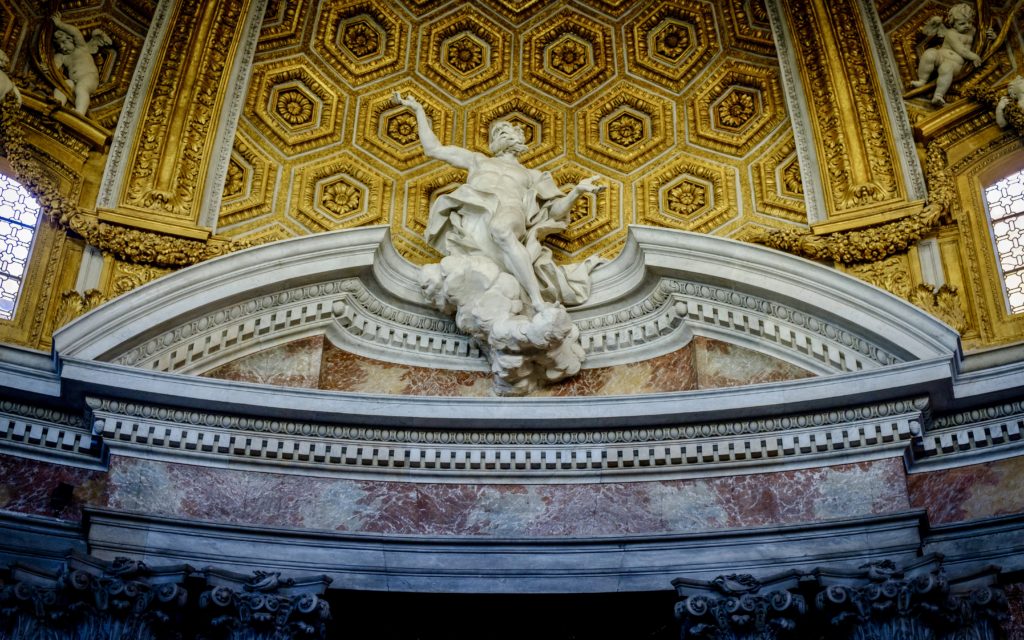
19. Sant’Andrea al Quirinale
This church was designed by Bernini in 1658 and was known as the “Pearl of the Baroque.” Bernini used a giant order of architecture.
The whole body of the church is enclosed within giant pilasters. The entrance looks like a giant gateway rather than a church.
The interior has an oval form. It’s colorful because many different types of marble and stone were used.
Above the high altar Bernini designed and carved fictive figures and cherubs that seem to tumble from the sky, lit from a window above. It’s a theatrical ensemble.
The central painting in the altar is the Martyrdom of Saint Andrew. The painting is framed in the same marble as the pilasters enclosing the altar.
The dome above is made of white stucco and gold. In the center is a dove representing the Holy Spirit. It’s surrounded by white marble sculptures. Some of the figures appear to look down on us.
I hope you’ve enjoyed my guide to the Bernini trail in Rome. You may enjoy these other Rome travel guides and resources:
- 8 one day in Rome itineraries
- 3 day itinerary for Rome
- 5 day itinerary for Rome
- Hidden gems in Rome
- Caravaggio’s Art in Rome
- Best Museums in Rome
- Guide to Palatine Hill
- Guide to the Roman Forum
- Guide to the Colosseum
- Archaeological sites in Rome
- Guide To St. Peter’s Basilica
If you’d like to discover Bernini’s art in Rome, pin it for later.

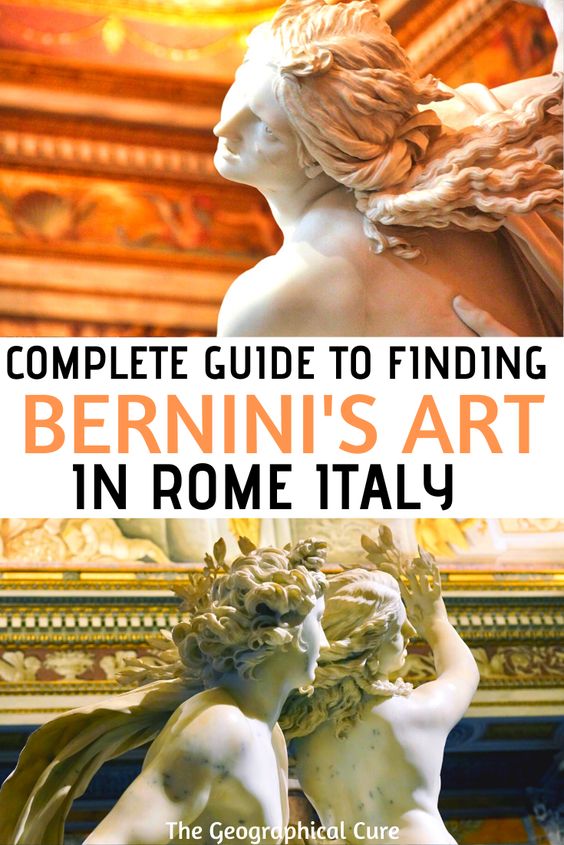
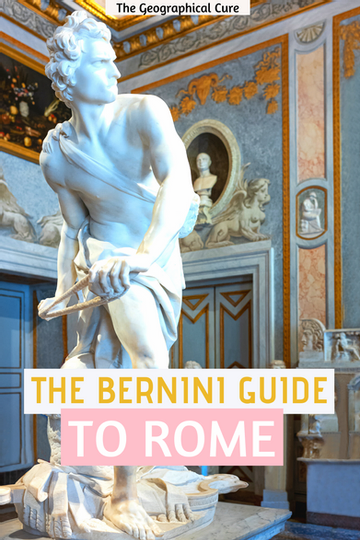
Thank you!
You’re welcome Vladimir!
You have done such wonderful research and with humor! I am bringing my class of 7th graders to Rome next month and I will use your photos and information to put together a Bernini treasure hunt. Thank you again!
That sounds like so much fun! Enjoy Rome!